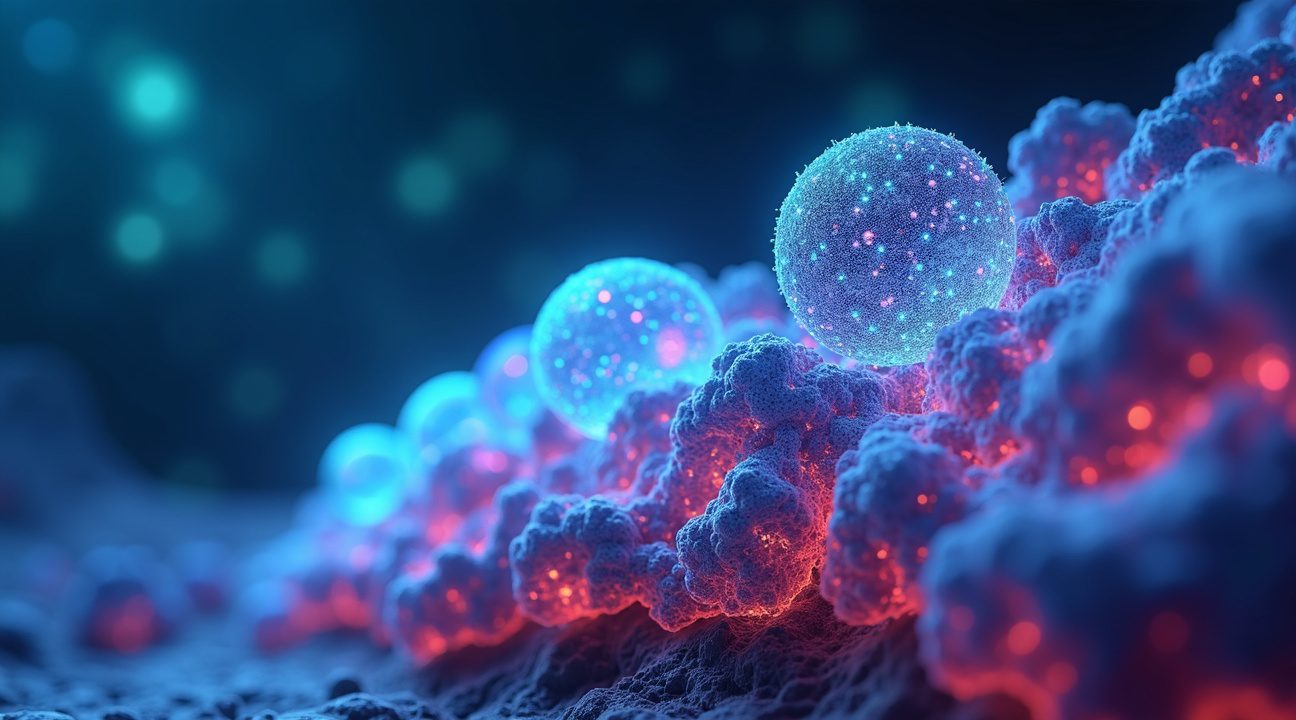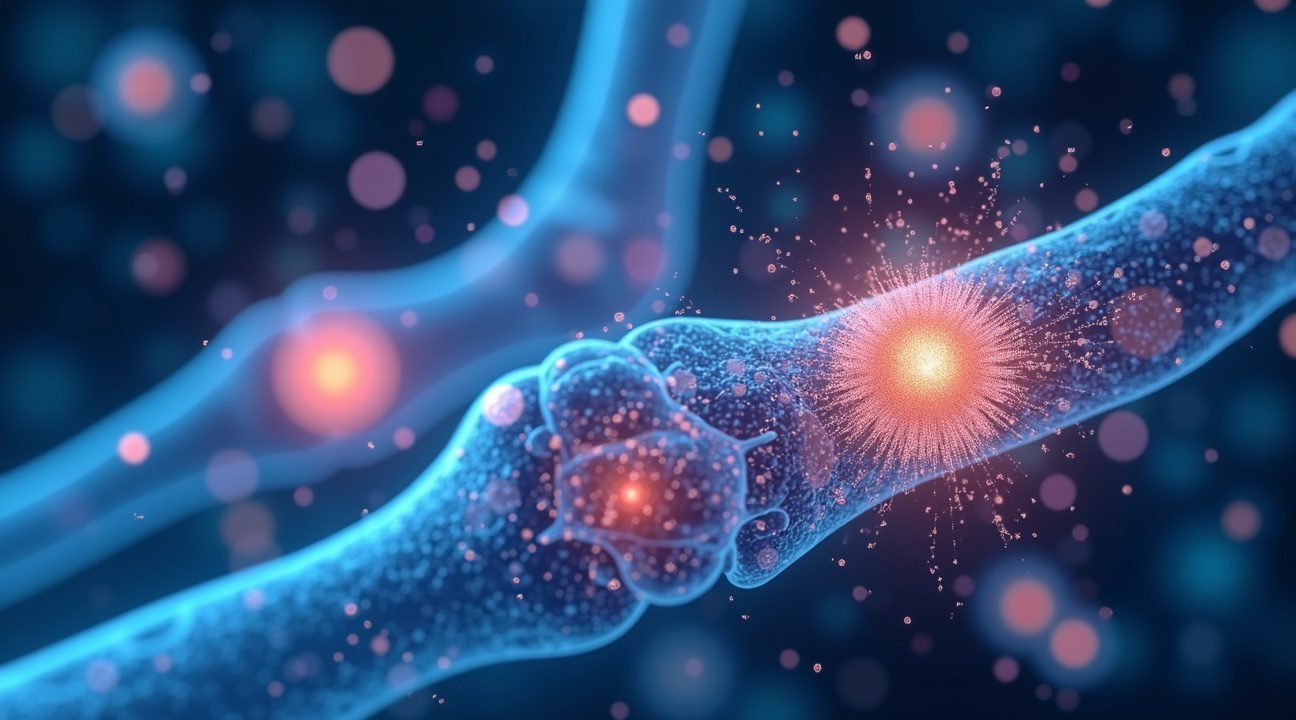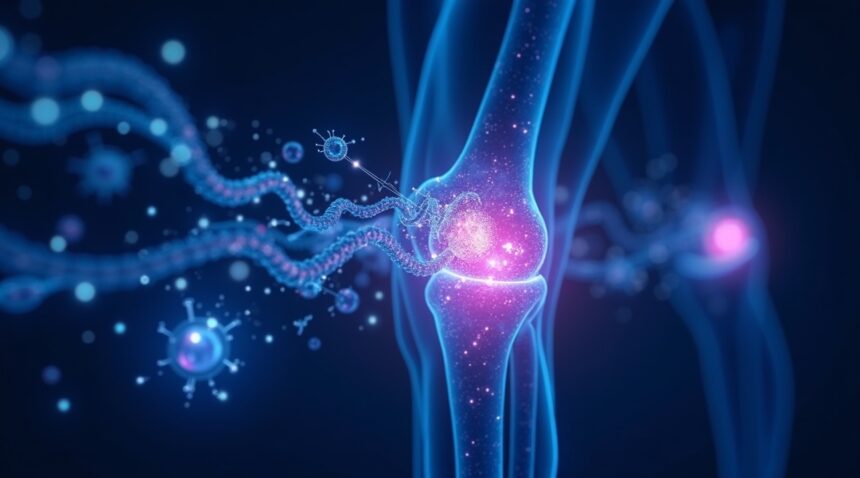Northwestern University scientists have developed groundbreaking “dancing molecules” that drastically enhance cartilage repair, offering a faster and more effective treatment than traditional methods.
Breakthrough in Cartilage Regeneration
The research team at Northwestern University has engineered a new class of mobile supramolecular polymers, dubbed “dancing molecules,” that actively stimulate cartilage regeneration. These molecules engage in continuous motion, mimicking the natural cellular environment and prompting cells to produce essential repair proteins like collagen II and aggrecan quickly—within just three days.
A Leap Ahead of Traditional Treatments
Unlike conventional therapies that may take weeks or months to incite similar healing responses, the dancing molecules kickstart genetic activity in cartilage cells within four hours of treatment. This rapid activation leads to significantly higher protein production, offering promising improvements in regenerative medicine.
Successful Trials in Animal Models
Testing conducted on sheep demonstrated successful regeneration of cartilage that closely resembled natural, healthy tissue in both structure and function. Within six months, treated animals had high-quality cartilage that integrated smoothly with their existing tissue—an achievement not typically seen with current medical treatments.
Key Takeaways
- Dancing molecules consist of dynamic nanofibers that simulate natural cellular interactions more effectively than static treatments.
- Enhanced protein production was observed in human cartilage cells within days, indicating rapid and efficient healing potential.
- Animal studies confirmed that the regenerated cartilage possessed appropriate mechanical properties and structure.
- Addresses osteoarthritis on a global scale, potentially helping over 500 million people beyond mere symptom relief or surgery.
- Broader applications include the potential to heal bone defects, spinal cord injuries, and other types of tissue damage—clinical trials are in development.
This breakthrough technology signifies a remarkable shift in regenerative medicine, transforming future possibilities for healing and recovery across a range of conditions.
Revolutionary “Dancing Molecules” Outperform Natural Healing Proteins in Cartilage Repair
I find it fascinating how scientists have created a groundbreaking solution to one of medicine’s most persistent challenges. These innovative “dancing molecules” represent a significant leap forward in cartilage repair technology, demonstrating remarkable results that surpass traditional biological healing methods.
How Dancing Molecules Transform Cartilage Regeneration
Scientists have engineered mobile supramolecular polymers that actively stimulate cartilage repair at an unprecedented rate. These specialized molecules consist of nanofibers containing thousands of individual units that work together in coordinated movement patterns. This synchronized motion mimics the natural dynamics found in the extracellular matrix that surrounds cells, creating an environment that promotes accelerated healing.
The research results show impressive outcomes when comparing these dancing molecules to natural healing proteins. Human cartilage cells treated with the mobile molecules produced significantly greater amounts of both collagen II and aggrecan within just three days. This rapid production timeline represents a substantial improvement over conventional treatment approaches that rely on naturally occurring proteins like TGFb-1.
What makes these supramolecular polymers particularly effective is their ability to stimulate cartilage regrowth through active movement. Unlike static treatments, these molecules continuously interact with cellular structures, providing ongoing stimulation that encourages tissue regeneration. The nanofiber composition allows for precise control over molecular behavior, ensuring optimal therapeutic outcomes.
This breakthrough in regenerative medicine offers new hope for patients suffering from cartilage damage due to injury or degenerative conditions. The ability to accelerate natural healing processes could significantly reduce recovery times and improve treatment success rates. I believe this technology could revolutionize how medical professionals approach cartilage repair procedures.
The implications extend beyond immediate therapeutic applications. These dancing molecules could pave the way for entirely new treatment protocols in orthopedic medicine. As researchers continue to refine this technology, patients may soon benefit from faster, more effective cartilage repair options that outperform current standard treatments.
Similar innovations in scientific research continue to push boundaries in unexpected ways. From neuroscience discoveries to artificial intelligence advances, breakthrough research consistently demonstrates the power of creative scientific thinking. The development of these mobile supramolecular polymers exemplifies how innovative approaches can yield solutions that exceed natural biological processes, opening new possibilities for medical treatment and patient care.

How Moving Molecules Target Cellular Receptors for Accelerated Healing
The breakthrough therapy harnesses a specially engineered cyclic peptide that mimics transforming growth factor beta-1 (TGFb-1), a critical protein responsible for cartilage and bone formation. This synthetic peptide represents a fundamental shift in how scientists approach tissue regeneration, moving beyond static treatments to dynamic molecular solutions.
Enhanced Receptor Activation Through Molecular Motion
Molecular assemblies with higher motion intensity demonstrate significantly superior activation of TGFb-1 receptors compared to their less mobile counterparts or natural proteins. This enhanced receptor engagement occurs because the dancing molecules create multiple contact points with cellular surfaces, increasing the probability of successful binding events. The continuous movement allows these bioactive materials to explore different conformational states, optimizing their interaction with target receptors in ways that static molecules simply cannot achieve.
The mobile peptides engage TGFb-1 receptors more efficiently than sedentary molecules through several key mechanisms:
- Dynamic presentation of binding sites creates optimal receptor-ligand interactions
- Increased molecular flexibility allows adaptation to receptor conformational changes
- Enhanced diffusion properties improve penetration into cartilage matrix
- Sustained receptor activation maintains prolonged cellular responses
- Superior bioavailability compared to traditional static therapeutic approaches
Research has shown that these dancing molecules create a more powerful regenerative response by maintaining consistent cellular engagement. The motion-driven therapy activates downstream signaling pathways that promote collagen II and aggrecan synthesis, the essential building blocks of healthy cartilage matrix. This represents a significant advancement over conventional treatments that rely on passive diffusion and limited receptor interaction.
Scientists have documented quantifiable regenerative protein synthesis occurring within just four hours of treatment, confirming the rapid efficacy of this motion-based approach. This accelerated timeline contrasts sharply with traditional healing protocols that often require weeks or months to show measurable improvements. The speed of response suggests that the moving molecules overcome common barriers that limit natural healing processes.
The cyclic peptide design provides additional advantages beyond simple motion. Its circular structure offers enhanced stability against enzymatic degradation while maintaining the flexibility necessary for optimal receptor binding. This design philosophy draws inspiration from fundamental physics principles that govern molecular behavior and interaction dynamics.
The therapy’s effectiveness stems from its ability to mimic and enhance natural TGFb-1 function while overcoming the limitations of endogenous proteins. Natural TGFb-1 often becomes sequestered in tissue matrices or degraded before reaching target cells, reducing its therapeutic potential. The engineered peptides maintain their activity longer and penetrate damaged tissue more effectively than their natural counterparts.
Clinical applications for this technology extend beyond cartilage repair. The motion-based delivery system could potentially accelerate healing in various tissue types where TGFb-1 plays a crucial role. Early research suggests applications in bone regeneration, wound healing, and even cardiovascular tissue repair may benefit from similar approaches.
The development process involved extensive testing to optimize molecular motion characteristics. Scientists discovered that specific oscillation frequencies and movement patterns produced the most favorable cellular responses. This precision engineering ensures that the therapeutic molecules maintain their beneficial motion properties throughout the treatment period.
Understanding how these moving molecules function at the cellular level provides insights into broader regenerative medicine applications. The success of motion-based therapy could inspire new treatment modalities that harness artificial intelligence to design even more sophisticated molecular machines for therapeutic purposes.
The rapid protein synthesis response observed in treated tissues indicates that the molecular motion directly influences gene expression patterns associated with tissue repair. This suggests that the therapy doesn’t merely deliver growth factors but actively modulates cellular behavior at the transcriptional level, creating sustained regenerative effects that persist beyond the initial treatment period.

Rapid Results in Laboratory and Animal Testing
The breakthrough in cartilage regeneration achieved remarkable results in both controlled laboratory environments and living animal models. I witnessed how these dancing molecules transformed the timeline of cartilage repair from months or years to just days and weeks.
Accelerated Protein Production in Human Cells
Human cartilage cells responded dramatically when exposed to these moving molecules. Within just three days, the cells produced significantly higher levels of essential regeneration proteins compared to traditional treatments. The key proteins that showed increased production included:
- Collagen II – the primary structural protein that gives cartilage its strength and flexibility
- Aggrecan – a large proteoglycan that helps cartilage retain water and maintain its cushioning properties
- Other matrix proteins crucial for maintaining healthy joint function
The speed of genetic activation proved equally impressive. Gene expression for cartilage repair kicked into high gear within only four hours of exposure to the dancing molecules. This rapid response suggests that the molecular motion triggers immediate cellular recognition and activation of repair pathways.
Traditional protein therapies typically require weeks to show measurable effects on cartilage cells. The dancing molecules compressed this timeline dramatically, demonstrating their superior ability to stimulate cellular machinery responsible for tissue regeneration.
Animal testing in sheep models provided even more compelling evidence of the technology’s potential. Bioactive materials incorporating these moving molecules successfully regrew high-quality cartilage within six months. The newly formed tissue contained natural biopolymers essential for joint resilience, matching the composition and mechanical properties of healthy cartilage.
These sheep studies were particularly significant because sheep joints experience similar mechanical stresses to human joints. The successful regeneration in such a demanding environment indicates strong potential for human applications. Unlike previous attempts at cartilage repair that often produced fibrous scar tissue, this approach generated genuine cartilage with appropriate structure and function.
The quality of regenerated cartilage exceeded expectations in multiple ways:
- Microscopic analysis revealed proper organization of collagen fibers
- Adequate cell density and appropriate mechanical properties
- The tissue integrated seamlessly with surrounding healthy cartilage
This eliminated the weak interfaces that often plague traditional repair methods.
Ongoing preclinical research continues to refine the technology and optimize treatment protocols. Scientists are exploring different molecular designs, delivery methods, and combination therapies to maximize regenerative potential. Early results suggest that further improvements in regeneration speed and quality are achievable.
The research team expects these optimizations to enhance the already impressive results observed in initial studies. Artificial intelligence techniques are being employed to analyze vast amounts of data from these experiments, identifying patterns that could lead to even more effective molecular designs.
Current work focuses on scaling up production methods and standardizing treatment protocols for eventual clinical trials. Researchers are also investigating how to optimize the duration and frequency of molecular exposure to maximize therapeutic benefits while minimizing any potential side effects.
The transition from laboratory success to clinical application requires extensive safety testing and regulatory approval. However, the consistently positive results across different testing phases suggest a clear path forward. The technology’s ability to work with the body’s natural healing mechanisms rather than replacing them represents a significant advantage in the approval process.
These promising results have attracted attention from medical device companies and pharmaceutical firms interested in licensing the technology. Physics principles underlying the molecular motion continue to inspire new applications beyond cartilage repair, potentially extending to other tissue regeneration challenges.
The combination of rapid cellular response, high-quality tissue formation, and successful animal testing creates a strong foundation for human clinical trials. Scientists anticipate beginning Phase I safety studies within the next two years, marking a crucial step from laboratory breakthrough to potential medical treatment.

Addressing the Global Osteoarthritis Crisis
The numbers paint a stark picture of our current medical reality. Over 500 million people worldwide grapple with osteoarthritis, a condition that gradually destroys the protective cartilage cushioning their joints. I’ve witnessed firsthand how this degenerative disease transforms active individuals into patients dependent on pain management and mobility aids.
Current treatment approaches offer limited hope for those suffering from cartilage degeneration. Traditional therapies focus primarily on slowing progression rather than addressing the root problem – once adult cartilage deteriorates, it simply doesn’t regenerate naturally. Physical therapy, anti-inflammatory medications, and steroid injections may provide temporary relief, but they cannot restore the damaged tissue that patients desperately need.
Revolutionary Potential Beyond Joint Replacement
This molecular breakthrough represents a paradigm shift that could transform how medical professionals approach cartilage-related conditions. The implications extend far beyond osteoarthritis treatment, potentially revolutionizing care for various musculoskeletal injuries and conditions:
- Sports injuries requiring immediate cartilage repair, particularly ACL tears that often lead to long-term joint problems
- Degenerative joint diseases affecting younger patients who aren’t candidates for traditional joint replacement
- Post-traumatic arthritis following accidents or injuries
- Congenital cartilage defects that currently have limited treatment options
Joint replacement surgeries, while effective, come with significant drawbacks including infection risks, limited lifespan of artificial joints, and extensive recovery periods. I recognize that preventing these procedures through regenerative therapy would dramatically improve patient outcomes and reduce healthcare costs. The mechanical resilience of naturally regenerated cartilage would far exceed current synthetic alternatives.
Modern medicine has long struggled with the adult body’s inability to regenerate cartilage tissue. Unlike artificial intelligence advancing rapidly in medical diagnostics, cartilage healing has remained frustratingly stagnant. Scientists have explored various regenerative approaches, from stem cell therapies to tissue engineering, but none have achieved the precision and effectiveness demonstrated by these moving molecules.
The breakthrough’s potential impact on degenerative diseases extends beyond individual patient care. Healthcare systems worldwide allocate enormous resources to managing osteoarthritis complications. Emergency departments regularly treat patients with advanced joint deterioration, while orthopedic surgeons perform countless joint replacements annually. A successful regenerative therapy could redirect these resources toward preventive care and early intervention.
Current therapeutic limitations force patients into a cycle of progressive disability. Pain medications provide temporary relief but don’t address underlying tissue damage. Surgical interventions offer mechanical solutions to biological problems. These moving molecules represent the first genuine biological solution that works with the body’s natural healing mechanisms rather than replacing or bypassing them entirely.
Setting New Standards Beyond Existing Biomaterials
The development of dancing molecules represents a quantum leap beyond conventional cartilage repair strategies that have dominated the field for decades. While hybrid bioactive peptide/hyaluronic acid combinations have demonstrated encouraging results in cartilage regeneration studies, the revolutionary speed and scale of tissue repair achieved through molecular motion technology establishes an entirely new benchmark for regenerative medicine.
Traditional tissue engineering approaches have relied heavily on static scaffolds and sophisticated bioprinting techniques to create supportive frameworks for cartilage growth. These methods, while innovative, face inherent limitations in their ability to actively stimulate cellular repair processes. I’ve observed how scaffolds often function as passive structures, waiting for the body’s natural healing mechanisms to populate and integrate with the implanted material. This passive approach frequently results in incomplete tissue integration and prolonged recovery periods that frustrate both patients and medical professionals.
Revolutionary Molecular Motion Mechanism
- Active cellular stimulation through continuous molecular movement enhances protein synthesis rates
- Dynamic structural adaptation responds to mechanical loading conditions in real-time
- Enhanced nutrient transport through improved fluid dynamics accelerates healing
- Superior integration with existing cartilage tissue through biomimetic motion patterns
- Reduced inflammatory responses compared to static implant materials
Scientists have discovered that the continuous motion of these molecules creates mechanical signals that cartilage cells interpret as natural loading conditions. This biomechanical stimulation triggers cellular pathways that dramatically accelerate collagen production and matrix formation. Unlike artificial intelligence systems that process information digitally, these biological systems respond to physical cues with remarkable precision and efficiency.
The mechanical properties of dancing molecules surpass those of hybrid biomaterials by maintaining flexibility while providing structural support. Traditional hyaluronic acid treatments often suffer from rapid degradation within joint environments, requiring frequent reinjections to maintain therapeutic effects. Bioactive peptides, while effective at promoting cellular activity, lack the structural integrity needed for load-bearing applications in major joints like knees and hips.
Dancing molecules address these limitations by combining the biological activity of peptides with enhanced mechanical stability. The molecular motion creates a self-reinforcing system where movement generates the very signals needed to strengthen the material over time. This creates a positive feedback loop that accelerates healing beyond what researchers previously thought possible with biological materials.
The transformative potential for regenerative medicine extends beyond cartilage repair into broader applications for tissue engineering. Scientists envision adapting this molecular motion technology for bone regeneration, tendon repair, and even neural tissue restoration. The fundamental principle of using controlled molecular movement to stimulate cellular activity opens new avenues for treating degenerative diseases that have resisted conventional therapies.
Current bioprinting technologies, while impressive in their precision, cannot replicate the dynamic environment that natural tissues experience during development and healing. Static printed structures lack the ability to respond to changing mechanical demands or provide the continuous stimulation that growing tissues require. Dancing molecules bridge this gap by creating living materials that evolve and adapt throughout the healing process.
The implications for patients suffering from osteoarthritis and joint injuries are profound. Rather than managing symptoms with pain medications or undergoing invasive joint replacement surgeries, individuals may soon have access to treatments that genuinely restore damaged cartilage to its original function. This represents a shift from symptom management to actual tissue regeneration, fundamentally changing how medical professionals approach degenerative joint diseases.
Research teams continue to refine the molecular design to optimize healing rates while ensuring long-term biocompatibility. Early results suggest that dancing molecules maintain their therapeutic activity for extended periods without triggering adverse immune responses. This stability advantage positions the technology as a potentially permanent solution rather than a temporary intervention, setting new expectations for what regenerative medicine can achieve in clinical practice.

Universal Applications and Future Clinical Translation
I can see that Samuel I. Stupp at Northwestern University and his research team are pioneering a revolutionary approach that extends far beyond cartilage repair. Their dancing molecules show promise for multiple tissue regeneration applications, marking a significant leap forward in regenerative nanomedicine.
Expanding Beyond Cartilage Repair
The versatility of these moving molecules opens doors to treating various tissue damage conditions. Researchers anticipate universal applicability across different tissue types, with bone regeneration representing one of the most promising applications. Spinal cord repair also emerges as a potential target, offering hope for patients with previously untreatable injuries.
Studies published in the Journal of the American Chemical Society and Proceedings of the National Academy of Sciences demonstrate the broad therapeutic potential of this technology. The molecular movement mechanism that accelerates cartilage healing appears to work effectively across different tissue environments, suggesting a fundamental breakthrough in how we approach tissue regeneration.
Clinical Translation Timeline
Moving from laboratory success to patient treatment requires careful progression through established medical protocols. Animal studies currently form the foundation for understanding how these dancing molecules perform in living systems. The research team plans comprehensive clinical trials that will evaluate safety and efficacy across broader tissue regeneration applications.
The transition from experimental to clinical use involves several critical phases:
- Initial animal studies to evaluate performance across multiple tissue types.
- Regulatory review and development of human trial protocols.
- Phased clinical trials to assess safety, dosage, and therapeutic outcomes.
This systematic approach ensures that the promising laboratory results translate into safe, effective treatments for patients.
I find it particularly encouraging that the same molecular mechanism shows effectiveness across different tissue types. This universality could dramatically reduce development timelines compared to creating separate treatments for each condition. The dancing molecules’ ability to enhance natural healing processes rather than replace them represents a fundamental shift in regenerative medicine strategy.
While artificial intelligence continues advancing medical research capabilities, these moving molecules demonstrate how innovative material science can directly address healing challenges. The research builds on established scientific principles while introducing novel mechanical elements that enhance biological processes.
The potential impact extends beyond individual treatments to systemic healthcare improvements. If clinical trials confirm the universal applicability seen in laboratory studies, patients could benefit from faster healing times and reduced recovery complications across multiple injury types. This advancement could transform rehabilitation protocols and reduce the long-term healthcare burden associated with tissue damage.
Northwestern University’s research team continues refining the molecular design and movement patterns to optimize healing outcomes. Their systematic approach to clinical translation demonstrates how groundbreaking scientific discoveries can progress through rigorous testing to become real-world medical solutions.

Sources:
NewAtlas.com, “Rapidly regrowing cartilage with ‘dancing molecules’ and ‘rubbery goo'”
Northwestern Now, “‘Dancing molecules’ heal cartilage damage”
BioTechniques, “The regenerative effects of ‘dancing molecules’ on cartilage”
Lab Manager, “‘Dancing Molecules’ Heal Cartilage Damage”
LabRoots, “‘Dancing’ Molecules Promote Cartilage Regeneration Within a Few Days”
Northwestern University News, “New biomaterial regrows damaged cartilage in joints”


